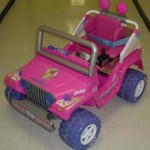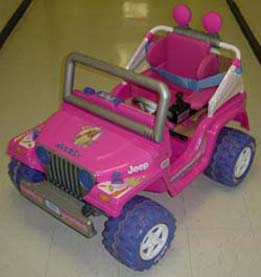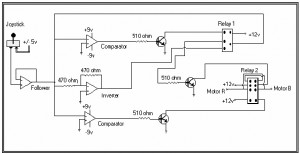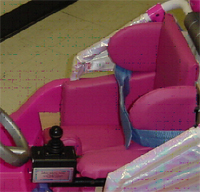Designers: Todd Atwood, Jeremy Bowman and Covey Lathan
INTRODUCTION:
Commercial Power Wheels vehicles cannot be easily controlled by children with poor muscle control. This project involved the modification of a Barbie Jeep for use by an 8-year-old girl with cerebral palsy. A joystick control and supportive seat were added to facilitate use and promote independence.
SUMMARY OF IMPACT:
The modified Barbie Jeep will allow the client to gain experience for future operation joystick-controlled wheelchairs and allows the client to have increased independence. The modifications allow the client to practice her fine motor control skills and visual-spatial skills, as well as encouraging active play and outdoor activity. The joystick controls allow forward/reverse motion, with future additions to include left/right control. The modified seat provides leg and torso support and a seat belt to ensure child safety.
TECHNICAL DESCRIPTION:
Analog based circuitry was chosen to provide a comparable driving experience when operating the car. The original 12 volt battery that comes with the car is maintained to operate the original propulsion motors, which require high currents. Two 9V batteries are used to power the joysticks and circuit components in the modified design. The batteries are located under the hood and have a power switch to turn the system on and off to preserve the batteries.
The joystick outputs a speed signal corresponding to the position of the lever. The signal range of the joystick is +2.6V to –3.0V as it moves along the y-axis. A comparator checks whether the signal is positive (forward motion) or negative (reverse motion), then relays number one and two are triggered to set the selected direction of motion for the motors.
The maximum speed of the modified car is slightly less than before the alterations. The speed is distributed evenly over the range of the joystick, and seems to be a safe velocity for both forward and reverse movement. The proportionality of the control will eliminate any jerky motions from the motors and provide for a smoother ride and acceleration.
The main limitation of the car is that the joystick does not control the left/right motion of the car. Because of the inability of the client to use the manual steering wheel, a parent or therapist must control the steering.
The seat of the car is specifically designed to provide torso support and hip support. A six-inch semicircle used to separate the client’s knees and an armrest is positioned on the left side to enable better joystick control. 1/8’ plywood is used as a base and back, and 1” x 6” quadrilateral pieces of wood were used for the hip supports.
Comfort and aesthetic value were important when incorporating the seat. Two layers of foam were added to each surface that contacts the client and the foam covered with pink vinyl to match the color of the jeep. This redesigned seat has the same dimensions as the original seat and will meet the client’s needs.
Approximate cost of the modifications to the car: $110.
This excludes the price of the car itself.






One Comment
Hello,
I came across your request while looking for spare parts for a child’s ride on scooter.
The following might be useful.
A speed control for RC electric car motors with reverse, might work well, you will need a signal from a “servo tester” to control it. See below for servo tester.
http://www.robotpower.com/products/scorpion_XL_info.html
http://www.modifiedpowerwheels.com/forum/topic.asp?TOPIC_ID=13458
You can buy two of “Servo tester” from a Radio Control hobby shop to control the Scorpion XL by wiring an external potentiometer to each Servo tester. One for steering and one for speed, forward and reverse.
I have not used the Scorpion XL but have some RC servo experience.
You might be able to get some help from the people at Robot Power.com
Ask if a potentiometer can be wired to the Scorpion XL .
I hope this is useful.
Regards
David McDonald.